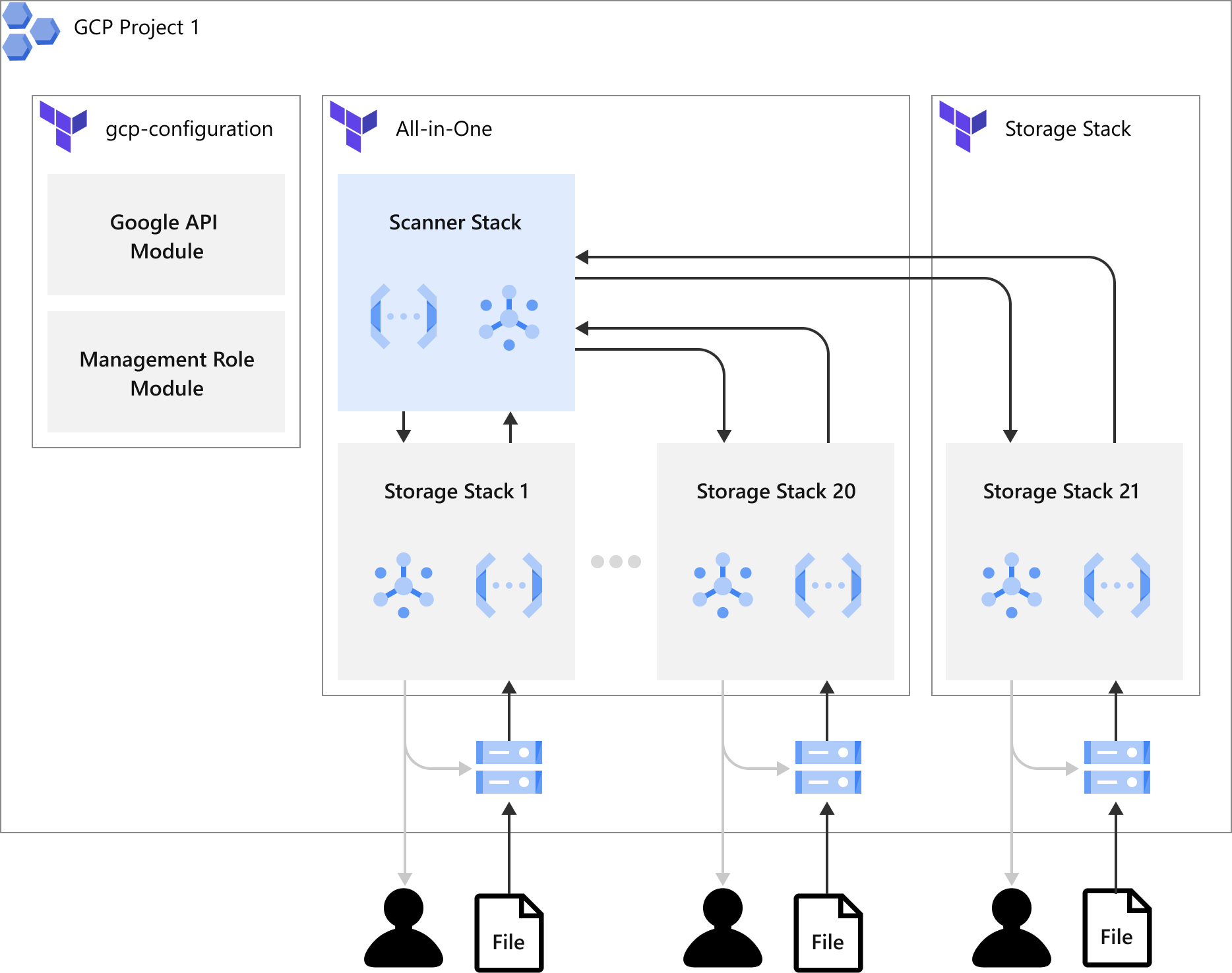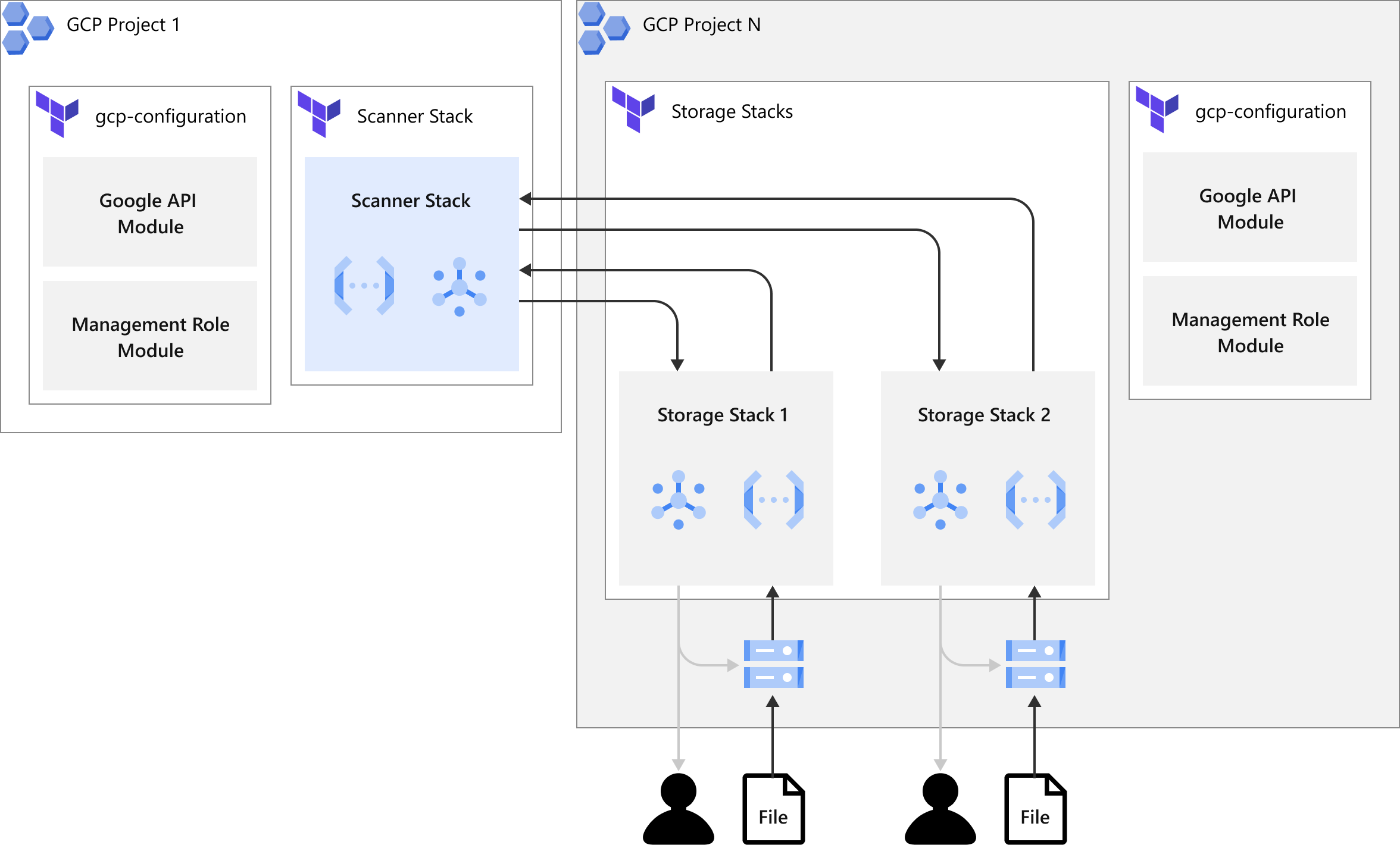After deploying File Storage Security, you might want to add more stacks.
Topics:
How many stacks should I add?
Storage stacks
You'll need one storage stack per Protecting bucket.
There is no limit to the number of storage stacks you can add, but keep in mind that
costs
will go up as the number of stacks increases. If you have a lot of files to scan that
are
spread across many storage accounts, consider deploying just one storage stack, and
transferring files into its associated storage account to scan and then back out after
scanning. We provide a sample Google Cloud Function that automates some of this work.
See Post-Scan Action: Promote or Quarantine on GitHub for details.
The number of storage stacks you deploy will not affect performance, so deploy as
many or as
few as you want.
Scanner stacks
Typically, you'll only need one scanner stack for your entire deployment regardless
of size.
This is because the scanner stack auto-scales to handle increases in load. (For details
on
performance, see How long do scans take?)
Where can I add stacks?
Unless otherwise noted, you can add stacks anywhere in GCP in separate GCP regions.
How Terraform deploys the stacks under your GCP project
All-in-One Stack Deployment
The illustration below shows how the All-in-One stack is being deployed by Terraform
in your
GCP project. You would need to apply a GCP configuration deployment once to your GCP
project
and then apply the All-in-One stack deployment. Each All-in-One stack deployment can
have 5
scanner stacks and 20 storage stacks. If the number of stacks exceeds the limit, you
would need
to create another stack deployment to extend the number of stacks.

Stack Deployment Cross GCP Projects
The illustration below shows how the stacks is being deployed by Terraform in cross
GCP
project scenarios. You only need to apply a GCP configuration deployment once in each
GCP
project and then apply the scanner stack and the storage stack deployment separately.
Each
scanner stack deployment can have 20 scanner stacks. Each storage stack deployment
can have 20
storage stacks. If the number of stacks exceeds the limit, you need to create another
stack
deployment to extend the number of stacks.

Add an all-in-one stack
For information on deploying a scanner and storage stack, see Deploy scanner
and storage stacks on GCP.
Add a scanner stack
Although you can deploy a scanner stack separately, we recommend that you deploy a
scanner
stack in conjunction with a storage stack.
Add the scanner stack following the instructions below.
Procedure
- In the File Storage Security console, go to , then select Deploy.
- To deploy the stacks, select Scanner Stack. The Deploy Scanner Stack dialog box opens.
- Make sure you're signed in to your GCP account.

Note
The GCP account must be connected in the Cloud One Cloud Provider Account list first. See Connect GCP account to Trend Cloud One. - Retrieve your Service Account:
-
Type in the GCP project ID.
-
Click Get.

Note
Paste this information in the managementServiceAccountProjectID and managementServiceAccountID variables of the Terraform deployment when you launch the stack.
-
- Configure and run the Terraform deployment:
-
Click Launch Stack to launch the Terraform deployment in the GCP Cloud Shell.
-
Click the Trust Repo check box to select it..
-
Set up your project:
- Under Project setup, select the project from the drop-down list.
- Execute the script in Cloud Shell.

Note
If you do not have a project ID, you need to create one:- Under Project setup, click **create a new one**.
- Create the project.
- Under Project setup, select the project from the drop-down list.
- Execute the script in Cloud Shell.
-
Enable permissions for deployment:You need to apply the settings and create the custom roles in the project before File Storage Security stack deployment. You only need to apply once on a GCP project for File Storage Security stack deployment:
-
Apply the GCP configuration deployment:Enable all the needed APIs and create the required custom roles by Terraform.
-
Specify the
projectIDinterraform.tfvars.jsonundergcp-configurationfolder. -
Specify the
customRolePrefixinterraform.tfvars.jsonif the prefix of the roles is needed. -
Apply the Terraform template in the Cloud Shell:
terraform -chdir=gcp-configuration init && terraform -chdir=gcp-configuration apply
-
-
-
Configure and deploy the stacks:Specify the following fields in
terraform.tfvars.jsonunder thescannersfolder and apply the Terraform template in the Cloud Shell.
Note
There could be multiple stacks in the JSON objectscannerStacks. There is a limit of 20 storage stacks per Terraform deployment. Please create another workspace in Terraform to separate the deployment if the number of stacks exceeds the limit.Terraform Input Variables:- projectID: Specify the project for this deployment.
- functionAutoUpdate: Enable or disable automatic remote code update. The
default value is
true. Allow values:true,false. - customRolePrefix: Specify the prefix of the custom roles if needed.
Scanner stack:- <SCANNER_STACK_NAME>: Specify the name of the scanner stack. The name, as a resource prefix, must be less than 17 characters. Replace the key with the scanner stack name.
- region: Specify the region for the scanner stack. For the list of supported GCP regions, please see Supported GCP Regions.
- managementServiceAccountProjectID: Copy and paste the service account project ID from the File Storage Security console.
- managementServiceAccountID: Copy and paste the service account information from the File Storage Security console.
-
Initialize and deploy in the Cloud Shell
```terraform -chdir=scanners init && terraform -chdir=scanners apply```

Tip
Please saveterraform.tfstateandterraform.tfvars.jsonfor managing the deployment
-
- Configure output in the File Storage Security console:To complete the deployment process, once the stacks are deployed, configure the management role:
- Copy the output content of
scanner_stacks_ouputsfrom the Cloud Shell output of Terraform. - Paste the content into the File Storage Security console.

Tip
You can get Terraform output by the command:terraform output - Copy the output content of
- Click Submit.
Add a storage stack
You can add additional storage stacks to a scanner stack. You cannot add storage stacks
that
are not associated with a scanner stack.
If you have already deployed an All-in-One stack in a GCP project and want to keep
your
scanner and storage stacks in the same project, please add the storage's JSON object
to your
All-in-One's
terraform.tfvars.json for managing the stacks in a single
Terraform deployment.To deploy your scanner and storage in separate GCP projects, use the following
deployment.
Add the storage stack:
Procedure
- In the File Storage Security console, go to , then select Deploy.
- Select the scanner stack that you want to use.
- Select Add Storage. The Add Storage Stack dialog box opens.
- Make sure you're signed in to your GCP account.
- Retrieve your Service Account:
- Type in the GCP project ID.
- Click Get.

Note
Paste this information in the managementServiceAccountProjectID and managementServiceAccountID variables of the Terraform deployment when you launch the stack. - Configure and run the Terraform deployment:
-
Click Launch Stack to launch the Terraform deployment in the GCP Cloud Shell.
-
Click the Trust repo checkbox to select it.
-
Set up your project:
- Under Project setup, select the project from the drop-down list.
- Execute the script in Cloud Shell.

Note
If you do not have a project ID, you need to create one:- Under Project setup, click **create a new one**.
- Create the project.
- Under Project setup, select the project from the drop-down list.
- Execute the script in Cloud Shell.
-
Enable permissions for deployment:You need to apply the settings and create the custom roles in the project before File Storage Security stack deployment. You only need to apply once on a GCP project for File Storage Security stack deployment:
-
Apply the GCP configuration deployment:Enable all the needed APIs and create the required custom roles by Terraform.
-
Specify the GCP project ID in
terraform.tfvars.jsonunder thegcp-configurationfolder. -
Specify the
customRolePrefixinterraform.tfvars.jsonif the prefix of the roles is needed. -
Apply the Terraform template in the Cloud Shell:
terraform -chdir=gcp-configuration init && terraform -chdir=gcp-configuration apply
-
-
-
Configure and deploy the stacks:Specify the following fields in
terraform.tfvars.jsonunder thestoragesfolder and apply the Terraform template in the Cloud Shell.
Note
There could be multiple stacks in the JSON objectstorageStacks. There is a limit of 20 storage stacks per Terraform deployment. Please create another workspace in Terraform to separate the deployment if the number of stacks number exceeds the limit.Terraform Input Variables:- projectID: Specify the project for this deployment.
- functionAutoUpdate: Enable or disable automatic remote code update. The
default value is
true. Allow values:true,false. - customRolePrefix: Specify the prefix of the custom roles if needed.
Storage stack:- <STORAGE_STACK_NAME>: Specify the name of the storage stack. The name, as a resource prefix, must be less than 17 characters. Replace the key with the storage stack name.
- scanner: Specify the name of the scanner stack.
- scanningBucketName: Specify the existing bucket name that you wish to protect.
- region: Specify the region of the storage stack. For the list of supported GCP regions, please see Supported GCP Regions.
- managementServiceAccountProjectID: Copy and paste the service account project ID from the File Storage Security console.
- managementServiceAccountID: Copy and paste the service account ID from the File Storage Security console.
- scannerProjectID: Copy and paste the scanner project ID from the File Storage Security console.
- scannerServiceAccountID: Copy and paste the scanner service account information from the File Storage Security console.
- scannerTopic: Copy and paste the scanner's Pub/Sub topic from the File Storage Security console.
- reportObjectKey: Select
trueto report the object keys of the scanned objects to File Storage Security backend services. File Storage Security can then display the object keys of the malicious objects in the response of events API. Allows valuestrue,false. - objectFilterPrefix: Enter the prefix of the objects you want to scan
from the bucket. Enter
''to scan without filters.
-
Initialize and apply the deployment in the Cloud Shell
terraform -chdir=storages init && terraform -chdir=storages apply

Tip
Please saveterraform.tfstateandterraform.tfvars.jsonfor managing the deployment
-
- Configure output in the File Storage Security console:To complete the deployment process, once the stacks are deployed, configure the management role:
- Copy the output content of
storage_stacks_ouputsfrom the Cloud Shell output of Terraform. - Paste the content into the File Storage Security console.

Tip
You can get Terraform output by the command:terraform output - Copy the output content of
- Click Submit.

